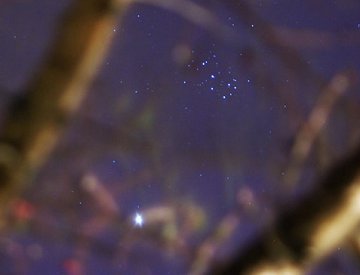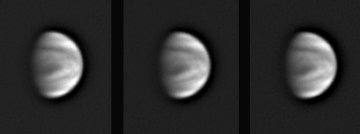 Did you miss last night's auroras? Next time get a wake-up call from Spaceweather PHONE.
Did you miss last night's auroras? Next time get a wake-up call from Spaceweather PHONE.
AURORA WATCH: Sky watchers from Scandinavia to Alaska should be alert for auroras on April 9th and 10th. A solar wind stream is due to hit Earth, and the impact could cause high-latitude geomagnetic storms.
VENUS AND THE PLEIADES: When the sun goes down tonight, step outside and look west. Brilliant Venus and the delicate Pleiades are almost side-by-side. Mohammad Taher Pilevar of Hamedan, Iran, took this picture just a few hours ago:

Photo details: Canon EOS 20D, 135 mm, 100 ASA
"On a cold windy night, the gathering of Venus and the Pleiades was a beautiful scene," he says.
The view will improve in the nights ahead as the planet and the star cluster draw even closer together. They'll be at their best on Wednesday, April 11th, when only 2.5o degrees of arc lie between them, and you can eclipse the pair with the tip of your thumb held at arm's length. Don't miss it! [finder chart]
more images: from Mila Zinkova of San Francisco, California
MYSTERY IN THE CLOUDS: Seen through an ordinary backyard telescope, Venus seems bland. It's a featureless, cloud-covered orb about as interesting as a billiard ball. But if that same telescope is fitted with an ultraviolet filter, a mystery reveals itself. Venus' clouds are cross-crossed with fast-moving dark bands, shown here in a series of March 30th photos from Ed Lomeli of Sacramento, California:

Photo details: Celestron 9-inch telescope, DMK 21BF04, UV pass filter
The bands are the mystery. Some unknown substance within them strongly absorbs UV light, accounting for almost half of the solar energy trapped by Venus. Whatever is in there, it plays a big role in maintaining Venus' hellish climate; the average temperature on the surface is about 460° Celsius. Astronomers have been studying the bands since Mariner 10 spotted them in the 1970s, but decades later no one knows the identity of the "UV absorbers." Candidates range from gaseous chlorine and sulfur compounds to alien life using UV radiation as a source of energy. Maybe Venus Express, a European spacecraft orbiting Venus now, will solve the puzzle.
To photograph the bands, Lomelli used a 9-inch Celestron telescope, a 640x480 monochrome ccd camera, and a 1.25-inch Schuler photometric UV pass filter. "I also have the Baader UV pass filter, but the Schuler is a better performer," he advises.

